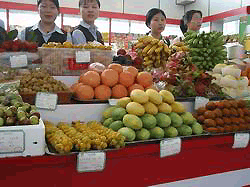|
High prices in airports: No hope to fall?
By Guan Xiaomeng (chinadaily.com.cn)
Updated: 2005-11-16 14:17
Feeling hungry at the airport during the tiresome wait for your flight? Or
need to buy some local specialties from airport shops just minutes before you
leave because you were too busy with business during your visit?
You may retract your hand from your wallet once you see the prices: 15 yuan
(US$1.85) for a bowl of instant noodles and 18 yuan for a kilo of longan (a kind
of pulpy fruit).
Feeling frustrated? It gets worse. Now your stomach groans, warning you of
hunger and the loudspeaker announces the flight time is near. Then you begin to
struggle: to buy or not to buy?
Known as "airport windfall profits," the sky-high price in airports has for
long been beyond ordinary people's reach and the target of complaints. The same
commodity sold in the airport is usually several times more expensive than its
market counterpart.

Fruits are shown in
an airport shop. Customers' complaints center on the prices of food,
drinks, fruits and souvenirs. [Xinhua] |
|
Despite the pressure from media exposure, "airport windfall profits" have
never stopped their money grabbing. As the media have strengthened its focus on
the high price in recent years, some big airports have adopted some measures to
lower the price, but with no significant improvements yet.
Why does the price in airports refuse to fall?
Besides high stall rents in airports, there is an underlying contradiction
that hinders the realization of rational prices.
An official from the
Baiyun International Airport revealed that high prices in airports are closely
bound to the fact that air travel has not become a common consumption for
ordinary people. That means that prices in airports depend largely on the
passenger volume and passenger purchasing power. The stall owners are likely to
extort a pile from a customer who suddenly appears in their shops.
Statistics show that people in the Chinese mainland travel by air just once
per year on average while the figure for Hong Kong people is 7 or 8 times on
average.
|